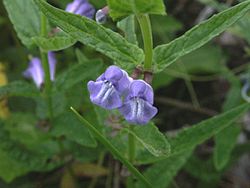Scutellaria galericulata
| Habit | herbaceous
| |
|---|---|---|
| Height: | ⇕ | 12 in"in" can not be assigned to a declared number type with value 12. to 24 in"in" can not be assigned to a declared number type with value 24. |
| Width: | ⇔ | 8 in"in" can not be assigned to a declared number type with value 8. to 12 in"in" can not be assigned to a declared number type with value 12. |
| Lifespan: | ⌛ | perennial |
| Exposure: | ☼ | sun |
|---|---|---|
| Features: | ✓ | flowers |
| USDA Zones: | 5 to 9 | |
| Flower features: | ❀ | blue, purple |
Common Skullcap (Scutellaria galericulata var. epilobiifolia), also known as Marsh Skullcap or Hooded Skullcap, is a hardy perennial herb native to Britain, Europe, and Asia. It is a member of the mint family Lamiaceae, which also includes many other herbs. The form is upright and is usually 0.2m to 0.45m in height [1][2]. It is a wetland loving species and grows along fens and shorelines. The blue flowers appear in July to September and are 10-20mm long. The flowers are in pairs and are all on the same side of the stem. The flowers do not appear at the top of the stem.
The plant is native to many parts of the world and, as such, is known by a variety of names. The Latin galericulata means hooded, relating to the length of the flower's tube being much longer than the calyx. [1]. The variation epilobiifolia translates as leaves like willow-herb [3], and refers to the slightly serrated long thin leaves which look similar to those of the genus Epilobium.
Read about Scutellaria galericulata in the Standard Cyclopedia of Horticulture
|
|---|
|
Scutellaria galericulata, Linn. Hardy, perennial by filiform stolons, 1-3 ft. high: lvs. ovate to oblong-lanceolate, about 2 in. long: fls. solitary in the axils of the upper lvs., about 1 in. long. June-Sept. In moist ground throughout the U. S. and Eu. CH
|
Cultivation
Propagation
Pests and diseases
Varieties
Gallery
References
- Standard Cyclopedia of Horticulture, by L. H. Bailey, MacMillan Co., 1963
External links
- w:Scutellaria galericulata. Some of the material on this page may be from Wikipedia, under the Creative Commons license.
- Scutellaria galericulata QR Code (Size 50, 100, 200, 500)
